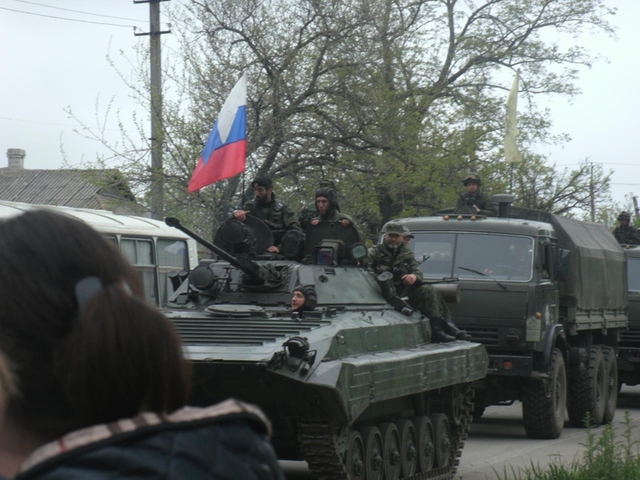The increased threat from Russia leaves security experts in Ukraine weighing various escalation scenarios. But if specific military actions on the ground leave enough room for speculation, it is absolutely certain that Russia is preparing the ground for a provocation via information operations. Its goal is to accuse Ukraine of aggression and justify the need for further military help to the Russian-speaking population in Donbas.
We are hardly talking about a war in the sense of “army against army,” but instead a hybrid war with some local military operations where disinformation and cyber-attacks are just as important as tanks and soldiers.
Russia’s build-up of troops and equipment near Ukrainian borders has been accompanied by a sharp escalation in both cyber attacks and disinformation campaigns. The rhetoric of pro-Kremlin sources has become much more aggressive. We see attempts to dehumanize Ukrainians, where they are often either portrayed as aggressors who are ready to kill at any time, or as western puppets who can be used by the West in an attempt to attack Russia.
Overall, Russian tactics are aimed at sowing fear, uncertainty, and testing the possible reaction of Ukraine and its allies. Another possible goal is to cover up the Kremlin’s military operations in the occupied Donbas.
The US reveals Russian plot
Last week US authorities said they had intelligence that showed Russia is planning to create a video depicting a fake Ukrainian attack, that it could release in order to justify its own invasion of Ukraine. The alleged plot would involve using corpses, footage of blown-up buildings, fake Ukrainian military hardware, Turkish-made drones, and actors playing the part of Russian-speaking mourners.
Russia planned graphic video with “corpses” as pretext for Ukraine invasion, US intel says
By revealing this intelligence information US made a move that will help deter Russia from this plan and, in case Russia still moves forward with it, will make it harder to spread disinformation and justify a possible military intervention.
So far this tactic proved to be effective. The disclosure of such information has already forced Russia to make excuses. Russian foreign minister Lavrov and Putin’s press secretary Peskov both made statements denying the allegations.
In addition, Russia has resorted to discrediting Western media. In the near future, we are likely to see publications that will make US warnings about a Russian threat appear absurd. But this does not mean that Russia abandoned the plan to destabilize Ukraine.
Pro-Kremlin disinformation unfolding
The density of the current information support of the Kremlin’s aggressive actions suggests that information operations in this round of Russia’s hybrid war have a special role. The escalating disinformation and manipulative messages that Kremlin-controlled media networks spread regarding the situation in Ukraine suggest that the situation is extremely serious and there is a real threat of Russian escalation against Ukraine.
Pro-Kremlin channels in media and social networks allege that Ukraine is getting prepared for attacking Donbas on a daily basis. The occupation authorities of the Russian puppet Luhansk and Donetsk “People’s Republics” regularly make statements about upcoming “bloody” provocations from Ukraine.
Pro-Kremlin media are trying to portray Ukraine as an aggressor who is preparing an attack on Donbas. Every day marginal Telegram channels come up with new “evidence” aimed at showing that Ukrainian forces alone, or with the help of Ukrainian allies – US, Canada, the UK — are preparing different sorts of provocations. Afterward, these messages migrate to the Russian mainstream media.
Who is orchestrating the spread of disinformation
The intensity of the information operations targeting Ukraine is growing every day. This is also connected with the supply of defensive weapons by the allies to Ukraine. Now the disinformation is aimed at accusing Ukraine of using these weapons to attack Russia’s hybrid forces in Donbas.
Amid Russian war scare, a “panic infrastructure” targeting Ukrainians unfolds in Facebook
Ukrainian military expert Oleksandr Kovalenko argues pro-Kremlin resources spreading disinformation are mostly supervised by the Russian Ministry of Defense and directly by the Main Directorate of the General Staff of the Armed Forces of the Russian Federation (GRU). Every day, they disseminate fake information about alleged “provocations and shelling and violations of the ceasefire by the Armed Forces of Ukraine,” and also report on the “death” of civilians in the Russian-backed “republics” from the alleged shelling of the Ukrainian army. No significant evidence is ever provided to ground these statements.
On January 29 Russian propagandists made up a report claiming that the Armed Forces of Ukraine shelled a substation in Yelenovka, using 60-mm mortars supplied from a shipment from the United States.
Another piece of disinformation emerged on 1 February, claiming a Ukrainian drone dropped an explosive device, killing one serviceman in the “Donetsk People’s Republic.” This was immediately picked up by a network of coordinated channels, which, as evidence, presented a photo of an allegedly Ukrainian drone. A quick fact check revealed that it had nothing in common with the drones used by Ukrainian armed forces.
After that on February 5th came false claims that Ukraine was shelling residential areas of Donetsk, also with no evidence.
The goal of all these campaigns is to develop a narrative that the Armed Forces of Ukraine are “killing” civilians in Donbas with American or British arms. Consequently, the United States and the United Kingdom, and all other countries supporting Ukraine, should urgently stop supplying arms to Kyiv.
What are the upcoming scenarios?
On February 11, the self-proclaimed chief of the “Donetsk People’s Republic” Denis Pushilin is preparing to convene a press conference for international media, where he will speak on “the genocide of citizens of the Donetsk People’s Republic by Ukraine; death and injuries of civilians, including children; destructions of infrastructure, the situation on the demarcation line, the Ukrainian army offensive preparation, provocations, mining, terrorist acts of the Ukrainian sabotage and reconnaissance forces.”
It means that all fakes already circulated in the pro-Kremlin media network about Ukraine and its Western allies preparing an attack will be presented at this “press conference.” Therefore, in the following days, the risk of wider-scale provocations and a further surge of disinformation will increase.
The presence of the Russian “war correspondents” in Donbas these days which are very well known for their connections to the Russian special services only reinforces these assumptions. Their presence in the region is an indicator that Russia is preparing a provocation, which these pseudo-journalists would cover, ready to blame Ukraine and the West at any moment.

Related:
- All roads lead to Ukraine: how Russia uses disinformation to support its efforts on the ground
- Strengthening the security resilience of Ukraine: military, energy, cyber
- Amid Russian war scare, a “panic infrastructure” targeting Ukrainians unfolds in Facebook
- Russia planned graphic video with “corpses” as pretext for Ukraine invasion, US intel says
- Why is Russia escalating now? Will it launch a major invasion of Ukraine? Three issues to consider.
- Epidemic of hoax bomb threats in Ukraine part of Russia’s hybrid war, emergency service says
- UK warns of Russian plan for coup in Ukraine. Here is what we know about its potential leader
- Ukraine’s Security Service says it neutralized over 2,000 cyberattacks in 2021
- Ukrainian official sites under massive cyberattack with a Russian trace








